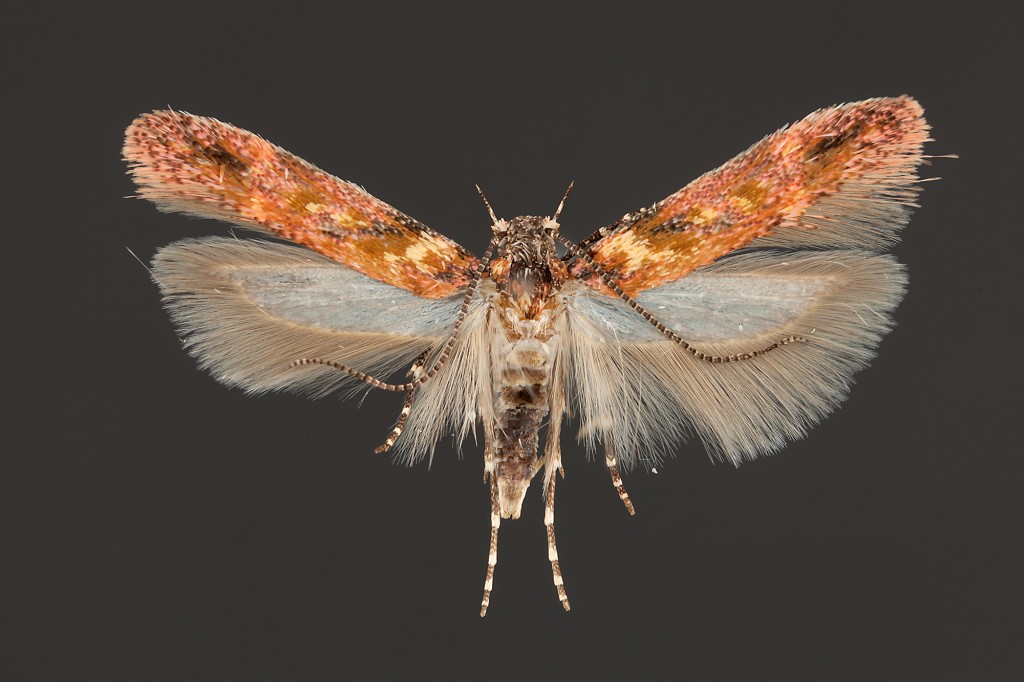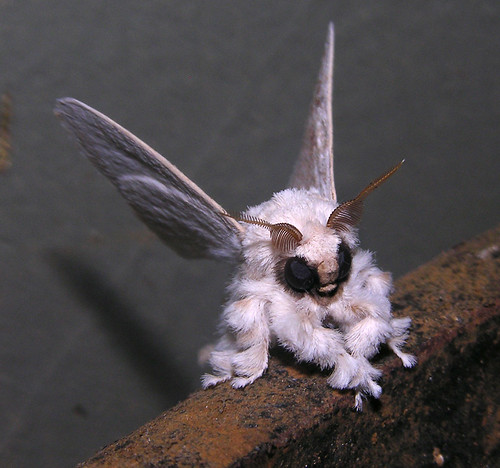Is speiceas álainn é leamhan an lae inniu ó na Sléibhte Rocky taobh amuigh de Denver, Epermenia stolidota (Epermeniidae). Is eiseamal níos mó é seo i ndáiríre ná mar is cosúil, thart ar 20mm ón sciathán go dtí an sciathán. Iad siúd a ardaíodh, dhorchaigh, Is carachtar iontach don teaghlach seo tuftaí scálaí ar imeall posterior an forewing, chomh maith leis na brístí righin ar an tibia hind (le feiceáil anseo freisin). Tá 11 speicis i 2 genera sna Stáit Aontaithe, agus gach seans go bhfaighfear cúpla ceann eile. D'eagraigh an cúntóir coimeádaithe eile David Bettman an speiceas seo trí athbhreithniú a dhéanamh ar an speiceas In aice láimhe: PDF anseo.
|
An tseachtain seo tá mé ag a roinnt beag bídeach, scruffy, agus leath-cumasach leathadh Nepticulidae sa ghéineas Stig Mella as an gaiste solas céanna Prescott Arizona mar cúpla Dé Luain Leamhain anuas. Ní ba mhaith liom a roinnt de ghnáth grianghraf de moth nach bhfuil sa riocht is fearr, ach tá mé ag baint úsáide as seo mar shampla de teicníc. Ní amháin go raibh an moth 4mm ceirteacha tarraingthe amach as an bun gaiste éadrom, ach bhí sé réimse pinned agus a thriomú le breis agus bliain go leith. Chuala mé i gcónaí gur féidir go mbeadh sé beagnach dodhéanta chun déileáil leis an lú de na beag; agus don chuid is mó nach bhfuil mé. Úsáid mé ag smaoineamh is gá duit iad a ghabháil amach ar bhileog éadrom beo i vial agus chuimhneacháin euthanize roimh leathadh, go léir riamh cé go, riamh lig dóibh tirim beagán tiniest roimh ré. Ach mar a casadh sé amach, is féidir leat a fháil amach le eiseamal réasúnta ag relaxing 24 uair an chloig agus a leathadh bun os cionn. Ar ndóigh, má tá tú eiseamal breá úr a sheachaint an cumascóir le buicéad-gaiste go mbeadh sé a dhéanamh le haghaidh eiseamal i bhfad níos fearr. Níos fearr fós, tharraing tú an mianach duille agus tógadh an moth féin. An chuid is mó de na Nepticulidae aíochta ar leith agus i bhfad níos éagsúla ná mar a mór dúinn a thabhairt dóibh creidmheasa. Chuala mé d'fhéadfadh a bheith ann ar a laghad, 100 speiceas nua ag fanacht fionnachtain sna Stáit Aontaithe ina n-aonar. Tá an scéal go leor féileacáin San Francisco go maith ar a dtugtar agus depressing. Tá tionchar an ceantar mór ag forbairt an duine ar feadh níos mó ná dhá chéad bliain agus is é an baile infamous leis an chéad sampla ar a dtugtar de féileacán Meiriceánach extinct, an Xerces blue. Cé go bhfuil féileacáin eile crochta ar, or getting help to hang on like the Misean Gorm, some like the Bay Checkerspot have continued to decline despite valiant efforts for reintroduction. Inniu, the only known colony of the Bay Checkerspot is within Santa Clara County on a site called Coyote Ridge. It was twenty one years of intensive study of the checkerspot in the 1960’s and 70’s by the famous biologist Paul Ehrlich that provided the impetus for federal listing in 1987. Ón 1998 the colonies he studied have since gone extinct. Here is an excerpt from a 1980 paper in the Journal of the Lepidopterists’ Cumann “Two California Checkerspot Butterfly Species, One New, One on the Verge of Extinction” (.pdf).
All efforts to relocate this butterfly have failed, and the future of this animal is not looking bright. And so what exactly is this creatures name? I 1937 Robert F. Sternitzky described what he thought to be an overlooked San Francisco butterfly “Euphydryas editha var. bayensis“. Those early descriptions of variations and races are roughly equivalent to today’s subspecies – and so the butterfly remained bayensis for decades and became a mascot for conservation. But where was the very first Euphydras editha from and how did the San Francisco bayensis differ? Unfortunately the original description is vague and the collecting locality is simply listed as “California”, as was the unfortunate habit of Boisduval who described the butterfly 1852. But all hope is not lost since the famous French Lepidopterist was having specimens sent to him by the earliest California Lepidopterist, Pierre Joseph Michel Lorquin. An eager gold prospector and butterfly collector, Lorquin traveled California from 1849 chun 1858 and again in 1869. Every butterfly that was sent back to France was a new species and subsequently described by Boisduval – who of course named one of California’s most beautiful butterflies after Lorquin. Enter Emmel, Emmel and Mattoon in 1994 who were writing the Systematics of Western North American Butterflies. In the process of cleaning up the mess of these early western species they had to designate a Lectotype for E. editha editha since Boisduval never fixed a Holotype in 1852. Essentially he named a new species without designating the taxonomic standard for the group, making future work ambiguous for taxonomists. Thankfully the travels of Lorquin have roughly been documented and we can ascertain that he should have been in San Francisco around 1849. Comparisons of the original specimens to the Bay Checkerspot made for an overwhelming case that it was this butterfly that was sent to France in the 19th century. The result of this finding therefore places the Bay Checkerspot Euphydryas editha bayensis into synonymy with the older name Euphydryas editha editha. The name bayensis effectively dissappeared because it was a re-description of a butterfly that was already known. Euphydryas e. editha as it turns out has been known from coastal California from the bay region down to San Luis Obispo – and so voila, the range of the Bay Checkerspot just exploded. But of course the story isn’t that simple and the butterfly didn’t become magically safe with a name change. Conservation groups and ecologist kicked and screamed and refused to accept the change, even the Xerces Society hasn’t jumped on board with the consensus of taxonomists out of what I can only assume is fear of the appearance that their butterfly is no longer endangered. I’ll emphasize that this doesn’t mean that the populations in the bay are no longer threatened – there is still a need for protecting these biologically significant populations as they are significantly declining. Habitats all throughout the region are facing ongoing and pernicious threats (pdf). All in all the name change is trivial, we can now call the Edith’s Checkerspot the Bay Checkerspot, and still fight to protect this butterfly. I’m unsure of what would be required to amend the federal register, and if it’s at all possible to expand protection of an animal like this without re-petitioning the endangered species act. So perhaps I can understand the failure to embrace the name change since from the outside it looks like their bug is no longer endangered. Ar an lámh eile, this could bring attention to populations of a butterfly that have been overlooked for decades.
Many thanks to John Pelham for conferring with me over this taxonomic headache.
Is sampla maith é an leamhan seo den mhéid atá i gcuid mhaith de mo leamhain i láthair na huaire – anaithnid! Gelechiidae é seo cinnte, is féidir leat na palps móra bun os cionn a fheiceáil ar thaobh tosaigh an chinn, agus teilgean cruth méar ar leideanna na gcliathán. Díreach thart ar cheann de na teaghlaigh is éasca de mhicreathoinne a aithint. Agus ó gestalt ginearálta b’fhéidir go bhfuil sé seo sa Gnorimoschemini? Má aithníonn duine an fear beag seo cuir in iúl dom é, ar shlí eile ionsaíoidh mé an litríocht chun an t-ainm a rianú. Tá an leamhan álainn seo ó na sléibhte taobh amuigh de Prescott, AN – Iúil 2010. Ina ionad sin taitneamh a bhaint as, tá an oiread sin microlepidoptera ann nach bhfuil furasta a aithint. B’fhéidir gur chuala tú cheana an nuacht chorraitheach maidir leis an athruithe atá le teacht ag Músaem Allamuigh Stair an Dúlra i Chicago. I mbeagán focal, tá an músaem i ngéarchéim airgeadais agus tá athruithe ollmhóra le cur i bhfeidhm ag an uachtarán nua, Richard Lariviere. Is dóigh go mbeidh suas le leath na foirne taighde ann (coimeádaithe tionachta san áireamh) leagfar as a phost é agus díscaoilfear gach roinn taighde “eolaíocht agus oideachas”. Caithfear airgead a nuachóiriú na dtaispeántas, go léir agus iad ag gutting croí eolaíoch an mhúsaeim. Tóg nóiméad le do thoil chun an achainí seo a shíniú agus do imní a chur in iúl: Taighde a Chosaint ag an Músaem AllamuighCúpla mí ó shin go leor de tú shiúil dócha ar fud an meme – the famous Poodle Moth! Agus go deimhin don chuid is mó a bhí an tuairisciú leath réasúnta. Is ea, tá sé fíor-. Is ea, tá sé ina moth. Is ea, is dócha go bhfuil speiceas sa Lasiocampidae (possibly the genus Artace) mar a dúirt i gceart ag an Dr. John Rawlins. I expected this to be all well and good, hey there are tons of cute moths out there and it’s about time someone noticed! I didn’t bother to read the article until a colleague forwarded it to me from the “Cosmic Log on nbcnews.com“. What I found was No real harm, but that whole cryptozoology thing gets me riled up. I think its unfortunate that a cryptozoologist nabbed so much publicity and was talked about with a fair amount of credibility. Cryptozoology is ní a science, nor will it ever be. When cryptozoology is conducted as a science it’s called biology. Yes there are nuts out there who believe they are conducting real science, following tall tales in circles and building stacks of anecdotal “evidence” that never seem to result in truths. There are real differences between what a scientist and a pseudoscientist does. Say a scientist hears reports of an odd animal living in the deep jungles – they embark on an expedition (after begging for funding) to do the hard work of piecing together local stories and trekking the jungles or diving the oceans to find the specimens. Then they bring those specimens home, dissect every detail, and publish the results in a peer reviewed journal. If no specimens were found then that scientist goes home empty handed and rethinks the possibility of this new mythical creature. Maybe more funding would give them more time in the field… (always the answer, ceart?) But the story ends there, without evidence the animal doesn’t exist. This is where cryptozoology departs from real science – they embrace anecdotal tales as fact and never admit defeat. Nessy exists because people féach him. The explanation can’t possibly be any large array of more plausible options… because the world a cryptozoologist lives in is mythical and fundamentally not real. OK enough ranting, let’s just hope for more adorable moths hitting the news cycle! Is micreathonn iontach é an leamhan inniu agus créatúr eile ó chlós cúil Barb Bartell sna Rockies. Ar feadh m'eolais is speiceas de Mamfa (Coleophoridae), is dócha claudiella,ach níl aitheantas dearfach agam ar an bhfabht seo fós. Nuair a thosóidh mé ag tochailt trí na miocrón ón suíomh seo is cinnte go mbeidh iontas orm! |
Amhras |










